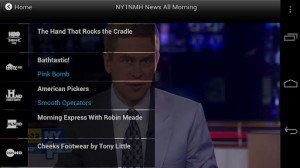If you are among the handful of people with an Android phone or tablet running Android v.4 (also known as ‘Ice Cream Sandwich’), Time Warner Cable’s latest version of its TWC TV for Android app introduces live streaming video.
Available as of 3pm ET this afternoon from the Google Play store, TWC TV for Android finally brings streaming video to an app that used to only allow Android owners to browse an online program guide and remotely manage their DVR boxes. Time Warner Cable originally introduced its TV Everywhere streamed video service on Apple’s iPad.
 But the company’s decision to limit streamed video only to the latest Android devices running Ice Cream Sandwich (ICS) is a major disappointment and will leave a lot of Android owners with a hobbled app.
But the company’s decision to limit streamed video only to the latest Android devices running Ice Cream Sandwich (ICS) is a major disappointment and will leave a lot of Android owners with a hobbled app.
“It’s currently the only version of the Android OS that allows us the security and stability necessary to distribute video over our private network,” claims Time Warner Cable’s Jeff Simmermon. “But it’s up to the device manufacturer and the sometimes the data carrier when or if ICS will be deployed to a particular device.”
Simmermon suggested the iOS platform developed by Apple was easier to contend with because one company developed the operating system and the devices on which it operates.
If you upgrade to the latest version of TWC TV for Android running on a non-ICS phone, a notification warns that live streamed video remains unavailable to you, leaving the app about as useful as its earlier version, which is to say not very. Simmermon also warns the upgrade is not available to “rooted” devices.
Smartphones purchased within the last year are likely to receive eventual upgrades to ICS, although exactly when depends on your wireless carrier. Older phones may or may not receive upgrades. As a general rule, the older the device, the less likely the manufacturer will be willing to keep upgrading it.


 Subscribe
Subscribe






